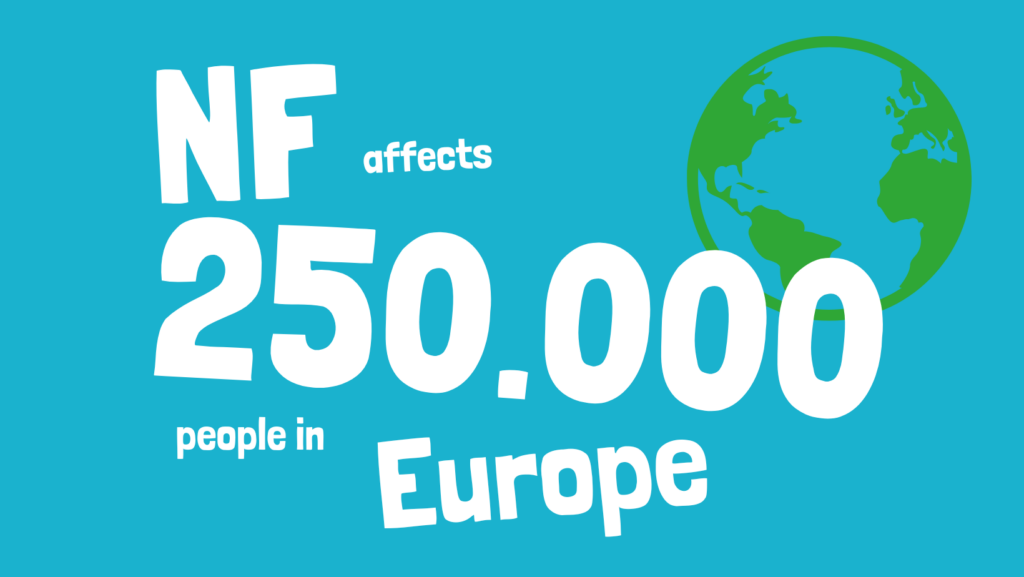
Neurofibromatosis is a rare genetic disease, that includes three different diseases that affect over 250,000 people in Europe. All are genetic diseases that can cause the growth of tumors on the nerves anywhere in the body, with severe consequences. Patients can go blind, deaf, develope chronic pain or life threatening tumors, amongst a large variety of other potential symptoms. Until now there is no cure for any of the three diseases. Of course the diagnosis is a shock for the patients and their families. They live constantly worrying about their health, trying to cope with a disease that is highly unpredictable.
About 200.000 people in Europe are affected by Neurofibromatosis Type 1 (NF1). The people affected are born with a genetic mutation in the NF1 gene. This affects the production of a protein called „Neurofibromin“. There is no cure or special treatment available today. Affected people have a 50% risk of passing on the disease to their children.
For children with NF1 hospital visits are part of their childhood. Over 100 different symptoms can manifest. The main issue of NF1 are tumours that can grow on the nerves anywhere in the body, including the brain, the spine, life important organs or the skin. Those mostly beneign tumours can be severly disfiguring and therefore can have a huge impact of the quality of life of the patients.
The course of the disease can be very different in each individual. You never know when and what will happen next in NF1. While children often have only mild symptoms, the diseases progresses with age and 99% of adult patients have benign tumours on the skin, so called cutaneous neurofibromas, which often cause cosmetic issues, itching and pain. Surgery options and off label treatments have clear limitations. The development of new treatments is urgently needed.
50% of NF1 patients have healthy parents.
NF1 can happen to anybody.
That’s why we all should care.
About 30.000 people in Europe are affected by NF2-related Schwannomatosis. The affected people are born with a genetic mutation in the NF2 gene. This affects the production of a protein called „Merlin“. There is no cure or special treatment available today. Affected people have a 50% risk of passing on the disease to their children.
NF2 can cause tumours on the nerves, emerging from the Schwan-cells. These tumours often occur in the brain and the spine. Leading to 50% of adult patients losing their hearing. Also facial paralysis, impairment of balance, headaches, chronic pain and also cosmetic issues can trouble the lives of NF2 patients.
Unlike NF1, NF2 can be hard to diagnose at a young age. The progression of the disease and the related tumours can lead to a quickly deteriorating health. Surgery options and off label treatments have clear limitations. The development of new treatments is urgently needed.
50% of the patients have healthy parents.
NF2 can happen to anybody.
That’s why we all should care.
About 19.000 people in Europe are affected by Schwannomatosis. The affected people are born with a genetic mutation in the SMARCB1 or LZTR1 gene.
Affected people have a 50% risk of passing on the disease to their children.
Schwannomatosis is very much alike as NF2. Brain tumours are less common in Schwannomatosis patients than in NF2 patients. It typically causes Schwannomas, benign tumors, that can occur anywhere on the nerves. They can cause severe, chronic pain and even lead to loss of function of a nerve.
85% of Schwannomatosis patients have healthy parents.
Schwannomatosis can happen to anybody.
That’s why we all should care.
> Find out more about Schwannomatosis on our youtube channel
NF Centers of expertise
“Orphanet” is an organsiation that has the aim to improve the diagnosis, care and treatment of patients with rare diseases. It is the reference source of information on rare diseases in and around Europe. If your are looking for an expert for NF in your country, you can find it here:
>> Orphanet: Search here for NF expert centres >>
Follow us:
